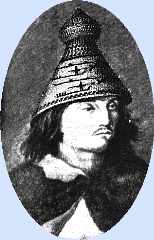 |
Basket Woven Hats and Footgear |
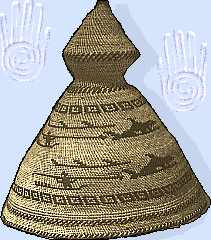 |
Distinctive domed hat of basket-twined cedar root worn by Nuu-chal-nuuth (Nootka) chief Maquina. Drawn by the Juan de Fuca expedition, 1792, west coast of Vancouver Island, BC |
 |
Westcoast Vancouver Ahousat elder and master basketmaker Jessie Webster made this beargrass (Xerophyllum tenax) and cedar domed hat (the style is calld Maquina) in 1982, modeled on the one drawn 200 years earlier.
|
|---|
| Beargrass grows in northerly locations. Its stems and roots are used for basketry in Oregon, Washington state, British Columbia, and in the subarctic. Mrs. Webster is the leading hat-basket weaver working on Vancouver Island. Her designs usually incorporate the traditional whale motif. Nuu-chah-nulth were mistakenly namd "Nootka" (meaning circling around) by whites. The 5000-member tribe has formally resumed their proper tribal name, "All along the mountains", under self-government. |
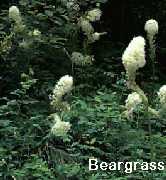 |
| Bowhead whales -- which are quite large -- were traditionally taken by whaling parties in large boats called umiaks made of whale ribs and walrus bones, covered with sealskin. Sealskin floats prevented the whale from diving too deeply. The whale's baleen -- a vertical mouth strainer of narrow cartilege strips for the microscopic sealife the baleen whales eat -- was also used to weave baskets. |
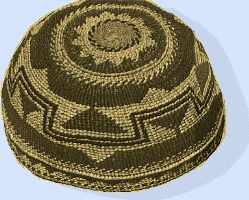 |
Karok weaver and elder Madeline Davis (Happy Camp, CA) twined this cap of bear grass, cedar bark, alder twigs, and fern root for the dark pattern, when she was in her 80's, her fingers arthritic from years of working basket materials in water. Weaving is usually done in winter, the water is quite cold. |
| Yurok woman photographed in the early 1900's wears a similar basket-woven cap. The purpose of these caps was to protect the forehead against tumplines from burden baskets. Pomo women did not need such caps, as they wove wide, soft straps which supplied their own protection. |
 |
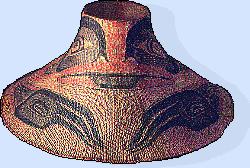 |
As the diamond weave detail on this Tlingit twined spruce root hat shows,
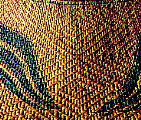 elaborate hats were woven even when painted, instead of with woven-in patterns. . elaborate hats were woven even when painted, instead of with woven-in patterns. . |
| This northwest coast woman, probably Haida, was drawn in the late 19th century, painting with a delicate brush on a similarly-shaped woven spruce root hat. Commercial dyes -- especially for red and blue -- had become popular trade items by this time, so woven items (as well as wood carvings) were decorated with them, instead of using the more laborious method of weaving in patterns with differently-colored plant fibers, as Mrs. Webster did. |
 |
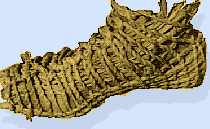 |
This whole-foot hurache or ankle boot is woven of softened roots, lined with grass and rabbit skin. University of California anthros didn't record what tribe made it. It was worn in rough, rocky country in winter. |
|---|
| More usual was simple toe-strap sandals, like these Digueño (Southern California Mission Indians) ones. They are made of stitched yucca fiber bundles, a technique that also was used to make a soft temporary baskets of tule grasses. The sandals provide protection for the foot sole on rough ground, but are not much good for going among rocks. Cahuilla also made similar sandals.
| 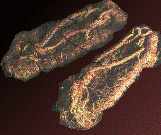 |
|
| Continue -- Multi-tribal gallery of baskets and Weavers |
|
CREDITS: The drawing of a Northwest Coast Indian encountered on Vancouver Island by Juan de Fuca's expedition is in a Madrid museum, and was scanned from The Indians of Canada, Diamond Jenness, University of Toronto Press, 1932; 1993. Jessie Webster's hat was a black and white photo in Tradition Lost and Found, Ralph T. Coe, University of Seattle Press, 1986, colorized by me. The beargrass photo by Michael Moore from the image gateway he maintains for Southwest School of Botannical Medicine. The Karok cap by Madeline Davis is from the Coe collection, coilorized by me. The Yurok woman's photo is in , A.L. Kroeber, 1918, Dover reprint, 1976. Tlingit hat from All Roads are Good. The Haida woman painting is from a CDROM photo archive maintained by Canada's SchoolNet, with poorly identified sources. The Tlingit hat was one of several chosen by Lloyd Kiva New to focus his essay ion All Roads Are Good, NMAI, 1993. The basket-woven hurache is from the California library collection's Shapes and Uses of California Basketry, colorized by me. The Digueno sandals ar from All Roads are Good, National Museum of the American Indian-Smothsonian, 1993.
Webmistress -- Paula Giese. Text and graphics copyright 1996.
Last Updated: Wednesday, October 23, 1996 - 2:53:22 AM




 elaborate hats were woven even when painted, instead of with woven-in patterns. .
elaborate hats were woven even when painted, instead of with woven-in patterns. .




